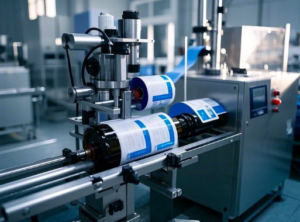The sticker labeling machine is an essential piece of equipment in modern packaging lines, used to apply adhesive labels to products such as bottles, jars, cans, and boxes. Its precise labeling capabilities are critical for product identification, marketing, and regulatory compliance. The sticker labeling machine consists of several key structures that work together to ensure accurate and efficient labeling of products. In this article, we will explore the main components of the sticker labeling machine and how they function to create high-quality labeling solutions.
1. Main Structure of the Sticker Labeling Machine
The sticker labeling machine is designed to provide seamless integration into production lines. The primary structure includes several core components that work together to apply labels accurately to a variety of products.
Key Components of the Sticker Labeling Machine
The main structure of the sticker labeling machine includes the frame, conveyor system, labeling heads, and control panel. The frame provides the foundational support for all other components, while the conveyor system ensures the steady movement of products through the labeling station. Labeling heads are responsible for dispensing, aligning, and applying the adhesive labels to products. The control panel allows operators to set parameters such as speed, label position, and machine diagnostics.
2. Labeling Head and Its Role in the Sticker Labeling Machine
The labeling head is one of the most critical components of the sticker labeling machine. It is responsible for applying labels to the products with precision and accuracy.
 Types of Labeling Heads in Sticker Labeling Machines
Types of Labeling Heads in Sticker Labeling Machines
There are generally two types of labeling heads used in sticker labeling machines: vertical and horizontal. The vertical labeling head is used for cylindrical products like bottles and jars, while the horizontal labeling head is typically used for flat or rectangular items like boxes. These labeling heads can apply labels to products at speeds ranging from 30 to 200 products per minute, depending on the machine’s design and the type of product being labeled.
Functionality of the Labeling Head
The labeling head is designed to accurately position the label on the product, ensuring that it is applied without wrinkles or misalignment. The machine can be calibrated to handle various label sizes, from small bottle labels to large package labels, with a high level of precision.
3. Conveyor System in the Sticker Labeling Machine
The conveyor system is another essential part of the sticker labeling machine. It transports products to and from the labeling station, allowing the machine to operate efficiently in a continuous flow.
Design and Speed of Conveyor Systems
Conveyor systems used in sticker labeling machines can be belt, roller, or chain type, depending on the type of product and the level of automation required. For example, belt conveyors are ideal for small to medium-sized products like bottles, while roller conveyors are better suited for heavier or larger items like boxes. The speed of the conveyor is typically adjustable, with most systems operating at speeds ranging from 10 to 100 meters per minute, allowing the machine to handle high production volumes.
Synchronization with Labeling Heads
The conveyor system is synchronized with the labeling head to ensure that products are consistently positioned for accurate labeling. The speed of the conveyor must match the labeling head’s dispensing rate to prevent delays or errors in the application process.
4. Control Panel and Adjustments in the Sticker Labeling Machine
The control panel is where the operator can adjust the settings for the sticker labeling machine. This structure allows for fine-tuning of various parameters, ensuring that the machine runs efficiently and effectively.
Settings Controlled via the Control Panel
The control panel allows operators to adjust several parameters, including labeling speed, label positioning, and the type of label being used. It also provides real-time diagnostics, alerting the operator to any potential issues like label jams or misfeeds. In modern sticker labeling machines, the control panel often includes touchscreen interfaces that are user-friendly and easy to navigate. The speed settings of the machine are typically adjustable, with most systems capable of handling between 30 to 200 labels per minute, depending on the product type and production requirements.
Conclusion
The sticker labeling machine is composed of several key structures that work together to ensure precise and efficient labeling. From the labeling head that applies the labels with accuracy to the conveyor system that moves products seamlessly through the machine, each component plays a crucial role in the overall operation. The control panel further enhances the functionality of the machine by allowing for easy adjustments to speed and positioning. As industries continue to require high-speed and high-precision packaging solutions, the design and functionality of sticker labeling machines will continue to evolve, offering more advanced features and greater automation for improved production efficiency.
